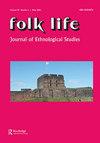难民仪式:马其顿希腊Anastenaria节日的延续与变化
IF 0.1
4区 社会学
0 FOLKLORE
引用次数: 0
摘要
摘要Anastenaria节是由来自色雷斯东部Kōsti村(现保加利亚)的难民后裔庆祝的,他们于1924年巴尔干战争后定居在希腊马其顿。这个节日是献给圣人Kōnstantinos和他的母亲Elenı的,他们被描绘在从Kßsti带来的圣像上。参与者的主要焦点是在被圣人附身时,在炽热的煤炭上欣喜若狂地跳舞。它被官方东正教禁止,以前是秘密进行的。尽管教会仍然认为这个节日是异教和基督教的结合,但官方宗教和Anastenarides之间的紧张关系已经缓解。本文基于对阿纳斯滕纳里德人和其他“土著”希腊人居住的两个村庄的实地调查,探讨了阿纳斯滕纳里德人的仪式空间如何复制Kōsti的原始空间。属于“从前”的邪教活动构成了一种与他们最初的家园相连的祖先邪教,“色雷斯人”通过宗教仪式庆祝他们的“Kōstilidian”身份。本文章由计算机程序翻译,如有差异,请以英文原文为准。
Refugee rituals: continuity and change in the Anastenaria festival in Macedonian Greece
ABSTRACT The Anastenaria festival is celebrated by descendants of refugees from the village of Kōsti in eastern Thrace, now in Bulgaria, who settled in Greek Macedonia by 1924, after the Balkan Wars. The festival is dedicated to saints Kōnstantinos and his mother, Elenē, depicted on holy icons brought from Kōsti. Participants’ primary focus is an ecstatic dance over red-hot coals while possessed by the saint. Proscribed by official Orthodox religion, it was formerly conducted in secret. Though the Church still considers the festival a combination of paganism and Christianity, tension between official religion and the Anastenarides has eased. Based on fieldwork in two villages inhabited by both Anastenarides and other ‘indigenous’ Greeks, this article explores how ritual spaces of the Anastenarides replicate the original space in Kōsti. Belonging to ‘former days,’ cultic practices constitute an ancestor cult linked to their original home, the ‘Thracians’ celebrating their ‘Kōstilidian’ identity through religious rituals.
求助全文
通过发布文献求助,成功后即可免费获取论文全文。
去求助
来源期刊
CiteScore
0.30
自引率
66.70%
发文量
17
期刊介绍:
Folk Life: Journal of Ethnological Studies is a journal devoted to the study of all aspects of traditional ways of life in Great Britain and Ireland. The journal publishes original, high quality, peer-reviewed research in the form of unsolicited articles, solicited papers (which are usually selected from those read at the Society"s annual conference) and of members" papers (which are usually short reports of work in progress). Work published in Folk Life may include, for example, papers dealing with the traditional ways of life of other countries and regions, which may be compared to or contrasted with those of Great Britain and Ireland.

 求助内容:
求助内容: 应助结果提醒方式:
应助结果提醒方式:


